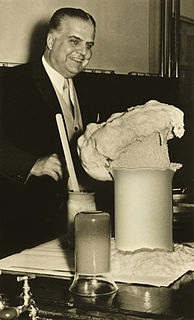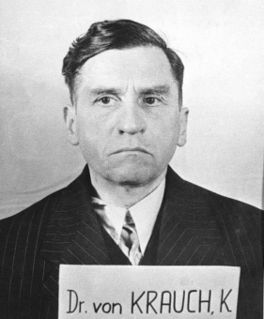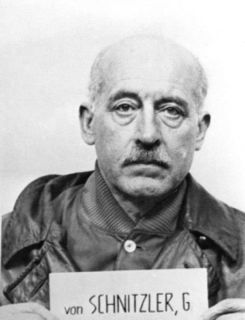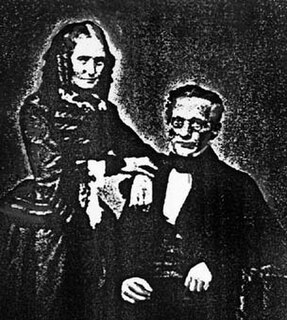Related Research Articles

Interessengemeinschaft Farbenindustrie AG, commonly known as IG Farben, was a German chemical and pharmaceutical conglomerate. Formed in 1925 from a merger of six chemical companies—BASF, Bayer, Hoechst, Agfa, Chemische Fabrik Griesheim-Elektron, and Chemische Fabrik vorm. Weiler Ter Meer—it was seized by the Allies after World War II and divided back into its constituent companies.

Goethe University is a university located in Frankfurt am Main, Germany. It was founded in 1914 as a citizens' university, which means it was founded and funded by the wealthy and active liberal citizenry of Frankfurt. The original name was Universität Frankfurt am Main. In 1932, the university's name was extended in honour of one of the most famous native sons of Frankfurt, the poet, philosopher and writer/dramatist Johann Wolfgang von Goethe. The university currently has around 45,000 students, distributed across four major campuses within the city.
There have been several people named Schnitzler :

Otto Bayer was a German industrial chemist at IG Farben who was head of the research group that in 1937 discovered the polyaddition for the synthesis of polyurethanes out of poly-isocyanate and polyol.

The IG Farben Building – also known as the Poelzig Building and the Abrams Building, formerly informally called The Pentagon of Europe – is a building complex in Frankfurt, Germany, which currently serves as the main structure of the West End Campus of the University of Frankfurt. Construction began in 1928 and was complete in 1930 as the corporate headquarters of the IG Farben conglomerate, then the world's largest chemical company and the world's fourth-largest company overall.
The Imprimatur GmbH was a company which owned the Frankfurt newspaper Frankfurter Zeitung (FZ) from 1930 until it was shut down in 1943. During the period that FZ was owned by the Imprimatur, the prestigious newspaper was in financial distress situations and brought the company heavy losses.

The Secret Meeting of 20 February 1933 was a secret meeting held by Adolf Hitler and 20 to 25 industrialists at the official residence of the President of the Reichstag Hermann Göring in Berlin. Its purpose was to raise funds for the election campaign of the Nazi Party.

Cassella AG, formerly Leopold Cassella & Co. and Cassella Farbwerke Mainkur AG, commonly known as Cassella, was a German chemical and pharmaceutical company with headquarters in Frankfurt am Main. Founded in 1798 in the Frankfurt Jewish Alley by Leopold Cassella, Cassella operated as an independent company until 1995 and was one of many predecessor companies of today's Sanofi. Its main products were dyes, drugs, cosmetics and various other chemical products. From 1949 Cassella focused increasingly on pharmaceuticals and cosmetics rather than its former primary focus, dyes. Much of its history is closely associated with the Gans family, a prominent family of industrialists and philanthropists and former owners of Cassella.

Carl Krauch was a German chemist, industrialist and Nazi war criminal. He was an executive at BASF ; during World War II, he was chairman of the supervisory board. He was a key implementer of the Reich’s Four-Year Plan to achieve national economic self-sufficiency and promote industrial production. He was Plenipotentiary of Special Issues in Chemical Production, a senator of the Kaiser Wilhelm Society, and an honorary professor at the University of Berlin. He was convicted in the IG Farben trial after World War II and sentenced to six years in prison.

Max Ilgner was a German industrialist. He was a member of the board of IG Farben and held the title Wehrwirtschaftsführer or war economy leader under the Nazi regime. After the war, he was convicted by the Allies of "spoliation and plunder", but released almost immediately, and continued his career as a political lobbyist and business executive, becoming chairman of a Swiss chemical company.

Georg August Eduard Freiherr von Schnitzler was a member of the board at IG Farben and a Nazi war criminal.

Friedrich Gajewski was a German businessman with IG Farben and Wehrwirtschaftsführer during the Second World War.
Carl Wurster was a German chemist and Wehrwirtschaftsführer during the Third Reich. He subsequently became one of the leading figures in post-war Germany's industrial life.

Peter Manuel Feldmann is a German politician of the Social Democratic Party (SPD). On 25 March 2012, he was elected Mayor of Frankfurt as successor of Petra Roth (CDU).

The Gans family is a prominent German family of industrialists and philanthropists from Frankfurt am Main. It is descended from Ludwig Aaron Gans, a Jewish businessman from Celle, who became an apprentice in the firm Caßel & Reiß in Frankfurt in 1814. In 1828, he married Rosette Goldschmidt (1805–1868), a niece and adopted daughter of the firm's owner Leopold Cassella, and was accepted as a partner of the firm. In 1848, Gans became sole owner of Leopold Cassella & Co., as the company was then named. Ludwig Aaron Gans was the father of the major industrialist Friedrich Ludwig von Gans, who was ennobled in 1912, and of the chemist and industrialist Leo Gans. The family converted from Judaism to Protestantism in the late 19th century.

Ludwig Aaron Gans was a German industrialist and owner of the company Cassella.
Werner Zerweck was a German chemist, inventor and industrial leader, who served as CEO of the chemical and pharmaceutical company Cassella from 1953 to 1963. Under his leadership the company focused increasingly on pharmaceuticals and cosmetics rather than its former primary focus, dyes. He was also a member of the advisory board of Deutsche Bank from 1953. Zerweck was one of the pioneers in the development of synthetic fibers.

Arthur von Weinberg was a German chemist and industrialist.
Christoph Kohl was a German chemist and industrial leader. He was chairman of the board of directors and CEO of the chemical and pharmaceutical company Cassella from 1964, chairman of its supervisory board and chairman of the supervisory board of Riedel-de Haën.

Carl von Weinberg was an important Jewish German chemist, entrepreneur, patron of the arts and philanthropist.
References
- ↑ Szilvinyi, Richard von, Hessische Biografie
- ↑ "Sein Leben galt der Wirtschaft. Richard von Szilvinyi im Alter von 67 Jahren verstorben", Frankfurter Allgemeine Zeitung , 30 April 1966